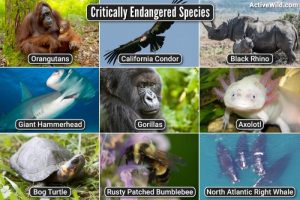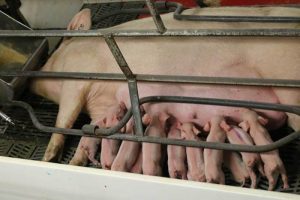
Embark on a wild journey exploring the fascinating realm of rare wild animals across the globe. From their distinctive characteristics to conservation efforts, get ready for a thrilling ride through the animal kingdom!
These elusive creatures are not just rare, but also play a crucial role in our ecosystem. Let’s dive deeper into their world to uncover the mysteries and marvels they hold.
Rare Wild Animals in the World
Rare wild animals are a fascinating and crucial part of our ecosystem. They play a vital role in maintaining the balance of nature and are often the subject of conservation efforts worldwide. Here are the top 5 rare wild animals found around the world:
1. Amur Leopard
The Amur Leopard is one of the rarest big cats in the world, with only around 100 individuals left in the wild. They are known for their beautiful coat, which helps them blend seamlessly into their forest habitat. Conservation efforts include anti-poaching patrols and habitat preservation to protect these majestic creatures.
2. Saola
The Saola, also known as the Asian unicorn, is a critically endangered species found in the forests of Vietnam and Laos. They are characterized by their long horns and shy nature, making them incredibly elusive. Conservation efforts focus on protecting their habitat and reducing illegal hunting.
3. Vaquita
The Vaquita is the world’s most endangered marine mammal, with less than 10 individuals left in the wild. These small porpoises are often caught in illegal gillnets, leading to their decline. Conservation efforts involve enforcing fishing regulations and working with local communities to find sustainable alternatives.
4. Pangolin
Pangolins are the most trafficked mammals in the world, prized for their scales and meat. All eight species of pangolin are threatened with extinction due to illegal poaching and habitat loss. Conservation efforts include raising awareness about the illegal wildlife trade and strengthening laws to protect these unique creatures.
5. Javan Rhino
The Javan Rhino is one of the rarest large mammals on Earth, with only around 60 individuals remaining in Ujung Kulon National Park in Indonesia. They are known for their solitary nature and distinctive skin folds. Conservation efforts focus on habitat protection and anti-poaching measures to ensure the survival of this critically endangered species.
Animals
Wild animals and domesticated animals differ in various ways. Wild animals are not bred by humans and live in their natural habitats. They have adapted to survive in the wild and are often more cautious and alert compared to domesticated animals. On the other hand, domesticated animals have been bred by humans for specific purposes like companionship, work, or food.
They are more accustomed to human interaction and rely on humans for their care and survival.
Well-known Wild Animals and Their Habitats
Wild animals are found in diverse habitats around the world. Some well-known wild animals include lions in the African savannah, polar bears in the Arctic, tigers in the forests of Asia, and kangaroos in the Australian outback. Each of these animals has evolved to thrive in their specific habitats, showcasing the beauty and diversity of wildlife across the globe.
- Lions: Lions are primarily found in the grasslands and savannahs of Africa. They are known for their majestic appearance and social structure within prides.
- Polar Bears: Polar bears inhabit the Arctic region, where they rely on sea ice to hunt for seals, their main source of food.
- Tigers: Tigers are found in various forested areas in Asia, such as India, Indonesia, and Russia. They are known for their striking orange coat with black stripes.
- Kangaroos: Kangaroos are iconic marsupials native to Australia. They are adapted to hopping long distances and can be found in diverse habitats ranging from grasslands to forests.
Preserving Natural Habitats of Wild Animals
Preserving the natural habitats of wild animals is crucial for maintaining biodiversity and ecological balance. Human activities such as deforestation, pollution, and urbanization have led to habitat destruction, threatening the survival of many species. Conservation efforts, protected areas, and sustainable practices are essential to safeguarding the habitats of wild animals and ensuring their long-term survival.
Impact of Human Activities on Wild Animals
Human activities have a significant impact on the lives of wild animals. Deforestation destroys habitats and disrupts ecosystems, leading to loss of biodiversity and endangering species. Pollution contaminates water sources and affects wildlife health, while illegal hunting and poaching threaten the existence of many iconic species. Climate change further exacerbates these challenges, altering habitats and migration patterns of wild animals.
It is crucial for humans to recognize their impact and take action to protect and preserve the natural world for future generations.
Livestock

Livestock animals are domesticated animals raised in agricultural settings for various purposes, including food production, labor, and materials such as wool or leather. They play a crucial role in supporting human livelihoods and economies around the world.
Differences Between Wild Animals and Livestock Animals
Livestock animals are bred and raised by humans in controlled environments, whereas wild animals live in their natural habitats without human interference. Livestock animals have been selectively bred over generations to exhibit certain traits desired by humans, while wild animals have evolved naturally to survive in their environments.
- Livestock animals are typically more docile and accustomed to human interaction compared to wild animals.
- Wild animals have specific habitat requirements and behaviors that are not present in livestock animals raised in captivity.
- Livestock animals rely on humans for food, shelter, and care, while wild animals fend for themselves in the wild.
Ethical Considerations in Livestock Treatment
The treatment of livestock animals raises ethical concerns regarding their living conditions, handling, and slaughter practices. It is important to ensure that livestock animals are treated humanely and provided with proper care throughout their lives. This includes access to food, water, shelter, and veterinary care to maintain their health and well-being.
It is essential to balance the needs of livestock production with ethical considerations for animal welfare.
Benefits of Sustainable Livestock Farming
Sustainable livestock farming practices promote environmental conservation, animal welfare, and economic stability. By implementing sustainable methods such as rotational grazing, organic feed production, and waste management, farmers can reduce their environmental impact and improve the overall health of their livestock.
- Sustainable livestock farming helps preserve natural resources and reduce pollution from agricultural activities.
- Improving animal welfare through sustainable practices enhances the quality of livestock products and consumer trust in the industry.
- By adopting sustainable farming methods, farmers can increase their resilience to climate change and market fluctuations.
Epilogue

As we wrap up our adventure into the world of rare wild animals, remember to cherish and protect these incredible species for future generations to admire and appreciate. The beauty of nature lies in its diversity, so let’s continue to preserve and celebrate these majestic creatures.
Key Questions Answered
What are some examples of rare wild animals?
Some examples include the Amur Leopard, Javan Rhino, and Vaquita Porpoise.
How do conservation efforts help protect rare wild animals?
Conservation efforts involve creating protected areas, breeding programs, and raising awareness to prevent their extinction.
Why is it important to preserve the habitats of rare wild animals?
Preserving habitats ensures these animals have a safe environment to thrive and maintain a balanced ecosystem.





